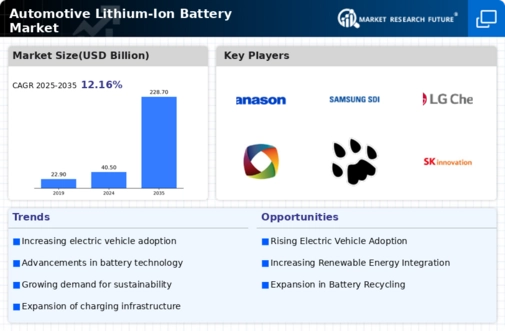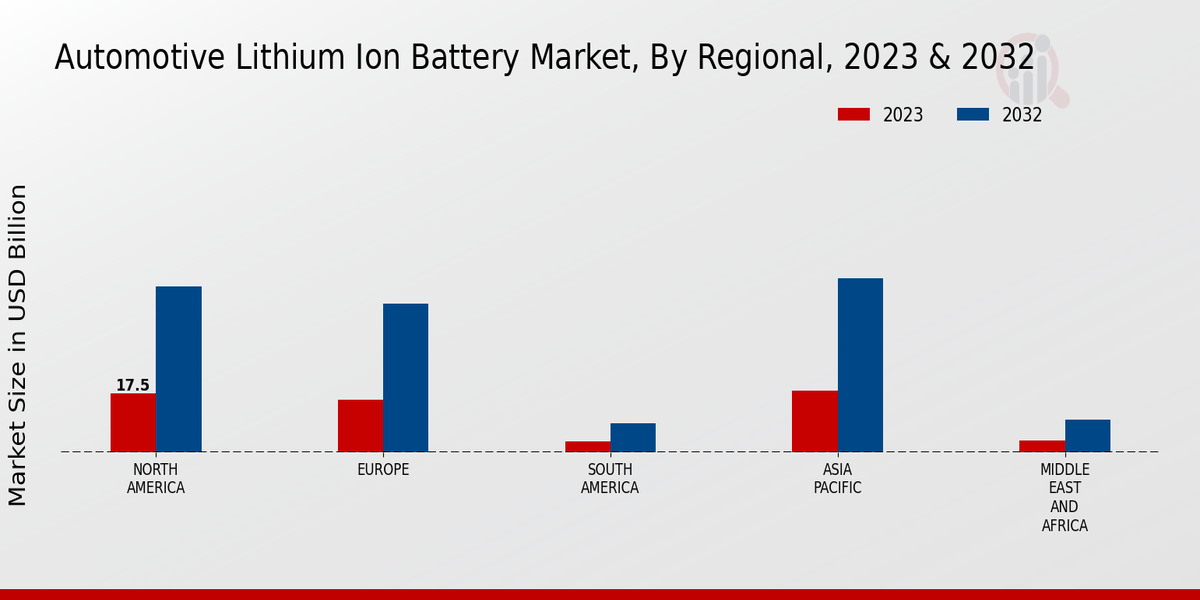Market Growth Projections
The Global Automotive Lithium-Ion Battery Market Industry is poised for substantial growth, with projections indicating a market size of 40.5 USD Billion in 2024 and an anticipated increase to 228.7 USD Billion by 2035. This growth trajectory suggests a compound annual growth rate (CAGR) of 17.05% from 2025 to 2035. Such figures highlight the increasing reliance on lithium-ion batteries in the automotive sector, driven by the rising demand for electric vehicles and advancements in battery technology. The market's expansion reflects broader trends in sustainability and innovation, positioning it as a critical component of the future automotive landscape.
Rising Demand for Electric Vehicles
The increasing global demand for electric vehicles (EVs) is a primary driver of the Global Automotive Lithium-Ion Battery Market Industry. As consumers become more environmentally conscious, the shift towards EVs accelerates. In 2024, the market is projected to reach 40.5 USD Billion, reflecting the growing adoption of EVs. Governments worldwide are implementing stringent emission regulations, further propelling this trend. For instance, countries like Norway and the Netherlands are setting ambitious targets for EV sales, which is likely to enhance the demand for lithium-ion batteries. This trend indicates a robust growth trajectory for the industry, as EVs require advanced battery technologies to meet performance expectations.
Expansion of Charging Infrastructure
The expansion of charging infrastructure is a pivotal factor influencing the Global Automotive Lithium-Ion Battery Market Industry. As more charging stations are established globally, the convenience of owning electric vehicles increases, thereby driving consumer adoption. This infrastructure development is crucial for alleviating range anxiety among potential EV buyers. Governments and private entities are investing heavily in charging networks, which is likely to support the growth of the lithium-ion battery market. With the anticipated growth in the number of electric vehicles, the demand for efficient and accessible charging solutions will continue to rise, further propelling the industry forward.
Government Incentives and Regulations
Government incentives and regulations play a crucial role in shaping the Global Automotive Lithium-Ion Battery Market Industry. Many governments are offering tax rebates, subsidies, and grants to encourage the adoption of electric vehicles and the development of battery technologies. For example, the United States has implemented various programs to support EV purchases, which in turn boosts the demand for lithium-ion batteries. Additionally, regulatory frameworks aimed at reducing carbon emissions are compelling manufacturers to invest in cleaner technologies. This supportive environment is likely to foster growth in the industry, as it aligns with global sustainability goals and encourages innovation in battery production.
Growing Focus on Renewable Energy Integration
The integration of renewable energy sources into the automotive sector is emerging as a significant driver for the Global Automotive Lithium-Ion Battery Market Industry. As the world transitions towards sustainable energy solutions, the demand for energy storage systems, including lithium-ion batteries, is increasing. These batteries are essential for storing energy generated from renewable sources such as solar and wind. The synergy between renewable energy and electric vehicles is likely to enhance the market's growth, as consumers and businesses seek to reduce their carbon footprints. This trend indicates a promising future for the industry, as it aligns with global efforts to combat climate change.
Technological Advancements in Battery Technology
Technological advancements in lithium-ion battery technology are significantly influencing the Global Automotive Lithium-Ion Battery Market Industry. Innovations such as solid-state batteries and improvements in energy density are enhancing battery performance and safety. These advancements not only extend the range of electric vehicles but also reduce charging times, making EVs more appealing to consumers. As a result, the market is expected to grow substantially, with projections indicating a rise to 228.7 USD Billion by 2035. The continuous research and development efforts by automotive manufacturers and battery producers suggest a commitment to improving battery technologies, which could lead to increased market penetration and consumer acceptance.



















